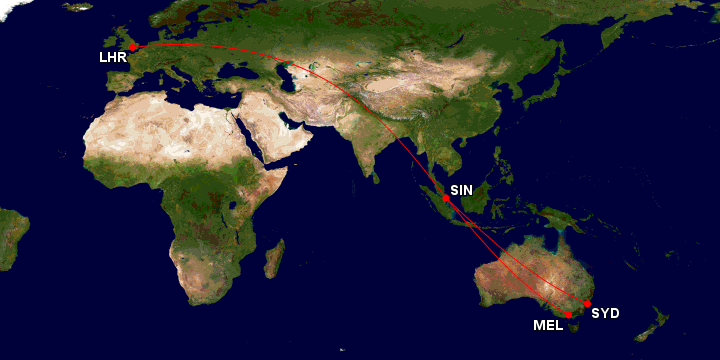Why Qantas can't just switch Melbourne twice daily A330 to once daily A380?
In the ongoing debate of where Qantas is likely to schedule the three returning A380s over the coming year, several followers on social media have proposed the idea that Qantas could consolidate their two daily Melbourne-Singapore A330 flights into a single A380 operated flight.
From a capacity perspective this makes sense as each A380 carries 485 passengers whereas each A330-200 carries 251 passengers in Qantas’s international configuration. Consolidating two A330-200s into one A380 flight results is a negligible difference of 17 seats per day, and even on days where one flight is operated by the larger A330-300 it only amounts to a loss of 63 seats.
Consolidating the two A330s flights into one A380 flight generates a small capacity loss but it actually improves the premium mix as the A380 offers a first and premium economy product that the A330s don’t, while also providing more business class seats.
As others noted, this would be useful to provide a premium economy (and first) product onwards to London. This seems like a fairly compelling proposition, so what’s the problem?
Frequency, frequency, frequency
Airlines continuously grapple with the challenge of whether to favour capacity or frequency. Operating fewer flights on larger aircraft can reduce unit costs, while operating higher frequency flights on smaller aircraft can generate higher unit revenue by offering more network connections and giving passengers more choice.
In the case of Melbourne-Singapore, one can see the choice of frequency by considering Qantas’s schedule. The two daily departures from Melbourne (QF35 and QF37) are spaced nearly 4 hours apart from each other whereas the return legs (QF36 and QF38) are spaced a little more than 3 hours apart from each other. One may argue that these are still close together, however there is limited scope to space them further without undermining additional network connections on both ends.
QF35 MEL SIN 12:05 18:15
QF37 MEL SIN 15:55 22:05
QF36 SIN MEL 20:15 5:35+1
QF38 SIN MEL 23:30 8:50+1Additionally, both flights have rapid turnarounds at Singapore, ensuring high aircraft utilisation that helps defray the higher unit costs generated by the higher frequency operation. QF35 turns around as QF36 in just two hours, while QF37 turns around as QF38 in less than that. Furthermore, when operationally needed, Qantas rotate aircraft with Brisbane, Perth or even Sydney A330 flights at Singapore.
So what’s the problem?
Why can’t they just replace QF35/36 or QF37/38 with an A380? For this, we have to consider the Sydney-Singapore-London schedule!
The outbound leg to London (QF1) is scheduled to arrive in London at 6:35am. This time is constrained by Qantas’s Heathrow slots and we can consider this exogenous for the time being. The return leg from London (QF2) utilises an evening departure slot, leaving London at 8:50pm.
QF1 SYD SIN 14:50 21:15
QF1 SIN LHR 23:25 6:35+1
QF2 LHR SIN 20:50 17:25+1
QF2 SIN SYD 19:30+1 5:10+2Heathrow’s slot constraints effectively define the departure times at Singapore, meaning QF1 departs from Singapore at 11:25pm for London. This means that QF35 from Melbourne to Singapore doesn’t generate an efficient connection, requiring passengers to hang around for over 5 hours. But it does generate a very efficient connection from QF37, requiring passengers to spend a little more than an hour in Singapore.
QF35 MEL SIN 12:05 18:15 -> 5:10 to connect to QF1
QF37 MEL SIN 15:55 22:05 -> 1:20 to connect to QF1
QF36 SIN MEL 20:15 5:35+1 -> 2:50 to connect from QF2
QF38 SIN MEL 23:30 8:50+1 -> 6:05 to connect from QF2On the return leg, QF2 gets into Singapore from London at 5:25pm. An onward connection to Melbourne on QF36 requires under 3 hours on the ground in Singapore, whereas taking QF38 requires more than 6 hours.
So for Qantas to consolidate the two Melbourne-Singapore flights into one while still maintaining the most efficient connections to/from London, it must maintain the timings from QF37 and QF36, while dropping QF35 and QF38. Hopefully you’ve noticed the problem.
QF37 MEL SIN 15:55 22:05
QF36 SIN MEL 20:15 5:35+1QF36 leaves Singapore two hours before QF37 arrives, meaning it can’t operate the schedule. The only way to manage this would be to utilise an additional A380 and have it spend 22 hours on the ground in Singapore, destroying aircraft utilisation. Effectively, instead of utilising two A330s to operate two daily Melbourne-Singapore flights, it’ll utilise two A380s to operate just one daily Melbourne-Singapore flight.
This doesn’t mean it can’t be done, but highlights the opportunity cost and challenge for Qantas.





